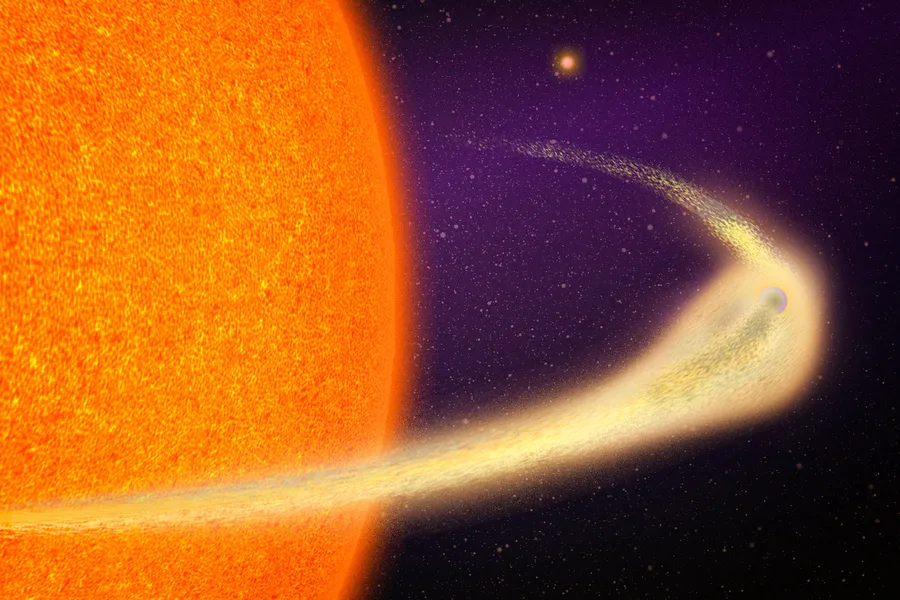Astronomers Discover a Doomed Exoplanet That's Crumbling Away and Leaving Behind a Comet-Like Tail
Astronomers Discover a Doomed Exoplanet That’s Crumbling Away and Leaving Behind a Comet-Like Tail
The planet orbits its host star in just 30.5 hours, losing a mass of material roughly equal to Mount Everest each time
An artistic rendering of an exoplanet in a tight orbit, followed by a dusty, comet-like tail of debris.
Jose-Luis Olivares / MIT
Astronomers have spotted a distant planet shedding matter with each orbit around its host star, generating a comet-like tail of debris. As detailed in a study published Tuesday in The Astrophysical Journal Letters, the discovery could have important implications for researching the interior of other rocky exoplanets.
Located 140 light-years away from Earth, the planet, named BD+05 4868 Ab, has approximately the same mass as Mercury—but its orbit around its host star is around 20 times closer than Mercury’s path around our sun. This proximity means the planet is likely roasting at nearly 3,000 degrees Fahrenheit.
As such, its surface is constantly boiling away and cooling into a long, trailing tail—which, at more than 5.5 million miles long, wraps around about half the planet’s orbit. The ill-fated world is rapidly disintegrating, losing approximately one Mount Everest’s worth of material with each 30.5-hour trip around its star, per a statement from MIT.
“This is a very tiny object with very weak gravity, so it easily loses a lot of mass, which then further weakens its gravity, so it loses even more mass,” study co-author Avi Shporer, of the MIT Kavli Institute for Astrophysics and Space Research, says in the statement. “It’s a runaway process, and it’s only getting worse and worse for the planet.” The researchers estimate the planet will disintegrate entirely within one to two million years.
BREAKING: A Disintegrating Planet with a Comet-like Tail
Watch on
Astronomers stumbled upon the doomed planet while using NASA’s Transiting Exoplanet Survey Satellite (TESS) to search for star transits: regular dips in light that could signal the presence of an orbiting exoplanet passing in front of its stellar host. During their search, they noted an irregular transit that took longer for the star’s brightness to recover. Further investigations confirmed it was indeed caused by an exoplanet—and the delay in the starlight’s return came from its comet-like tail.
“You don’t actually see the planet—it’s too small—but you have this large dust tail, which obscures light from the star itself,” Marc Hon, a postdoc in MIT’s Kavli Institute for Astrophysics and Space Research, said during a press conference earlier this year, when the study had only been released as a preprint, per Sky & Telescope’s Arielle Frommer. “The shape of this dimming event is unlike any other that we’ve ever seen on a typical planet.”
BD+05 4868 Ab is only the fourth disintegrating exoplanet astronomers have ever observed. But even among these crumbling worlds, it has the longest tail and deepest transit, suggesting it’s disappearing faster than the rest. This exoplanet and its host star are also the “closest” to Earth, offering an excellent excuse to put NASA’s James Webb Space Telescope to work investigating the composition of the planet’s tail.
“The tail is expected to contain minerals evaporated from the surface or interior of the disintegrating planet. So, this could be the crust, mantle or even the planet’s core,” Hon says to Reuters’ Will Dunham. “Learning about the interiors of planets is extremely challenging. Doing this even for planets within our solar system is difficult. But BD+05 4868 Ab will allow us to directly measure the mineral composition of a terrestrial planet outside our solar system.”
In this way, the planet offers a key opportunity for researchers to better understand distant rocky worlds.
“We got lucky with catching it exactly when it’s really going away,” Shporer says in the statement. “It’s like [it’s] on its last breath.”
Get the latest stories in your inbox every weekday.


